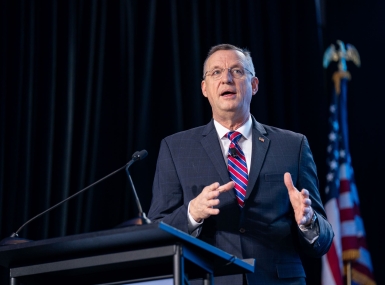President Biden signs sweeping veterans’ health package into law
Author
Upcoming Events
Related News

Key Takeaways
On August 10, President Biden signed the bipartisan Honoring our Promise to Address Comprehensive Toxics (PACT) Act into law, ushering in a significant expansion of U.S. Department of Veterans Affairs (VA) disability and health benefits for veterans suffering from medical conditions due to toxic exposure during their military service. Counties support the PACT Act, which will ensure millions of veterans can now access the federal health care they are owed for sacrifice to the nation.
An estimated 3.5 million veterans were exposed to environmental hazards and other toxic substances, such as burn pits, during the Global War on Terror alone. However, burdensome procedural hurdles have long blocked access to VA medical care and disability coverage for these and other toxic-exposed service members. In response, the PACT Act adds 23 burn pit and toxic exposure-related conditions to VA’s list of service presumptions and expands presumptions related to Agent Orange exposure, allowing VA to assume certain medical conditions are the result of military service during a given period in a specific location. The new law also expands VA health care eligibility for ten years to certain post-9/11 combat veterans, and it creates a framework for the establishment of future presumptions of service connection related to toxic exposure. To support implementation of these provisions, the PACT Act further invests in VA’s resources and training, claims processing, workforce and health care facilities.
Under the PACT Act, millions of veterans will be newly eligible to file claims for critical medical care and disability benefits. In 29 states, County Veteran Service Officers (CVSOs) will be on the front lines assisting veterans with this often complex process. Though these officers primarily work to help veterans access their federal benefits, they are supported almost entirely by counties and local taxpayers, creating challenges for areas with high demand and counties serving veterans in rural areas.
The expected rise in caseloads stemming from the PACT act underscore the need for Congress to swiftly pass the bipartisan Commitment to Veteran Support and Outreach (CVSO) Act (H.R. 4601/S.2405), which would authorize $250 million over five years for states to expand CVSOs or similar government entities. These federal resources will be essential for ensuring that this county workforce is prepared to help veterans access the health and disability benefits they so urgently need. Counties urge Congress to pass the CVSO Act immediately to support effective implementation of the PACT Act at the local level.
On August 11, VA also launched a landing page to communicate information about the PACT Act, including processes for eligible veterans to apply for benefits.
NACo will continue to monitor the Biden Administration’s implementation of the PACT Act and Congressional action on the CVSO Act.
Featured Initiative
Operation Green Light for Veterans
During the week leading up to Veterans Day, counties shine a green light to show support for veterans, raise awareness of benefits available to them and call for action on federal policies that support veterans and their families.

Related News

Helping veterans, with an assist from counties, is ‘priority number one,’ VA secretary says
County officials can “touch more lives than any member of Congress or any governor,” because they see their constituents every day, said Doug Collins, the new VA secretary.

County Countdown – January 14, 2025
Every other week, NACo's County Countdown reviews top federal policy advocacy items with an eye towards counties and the intergovernmental partnership.

